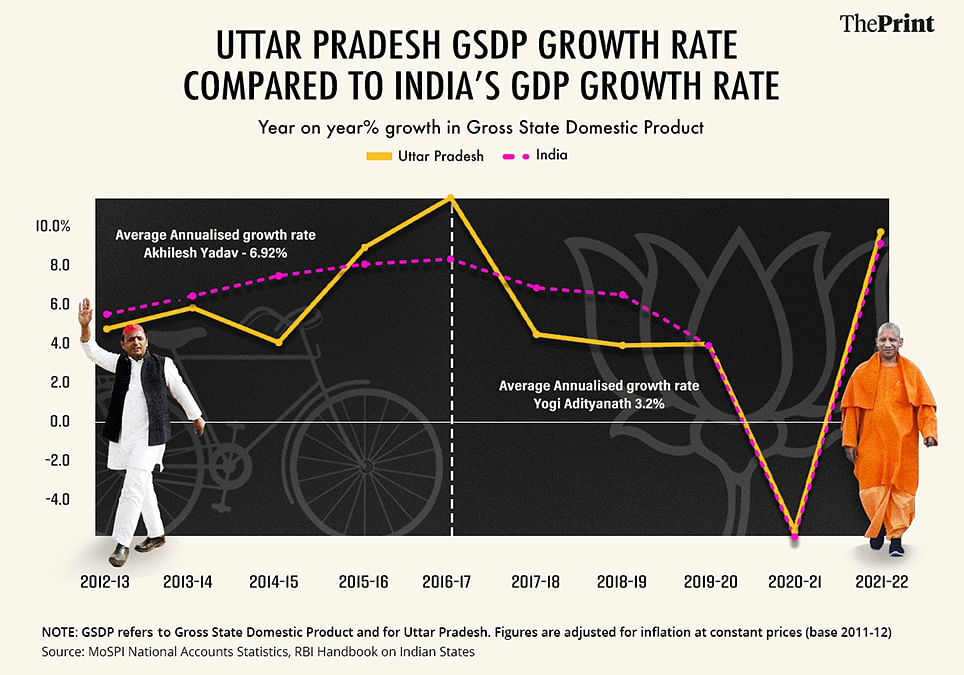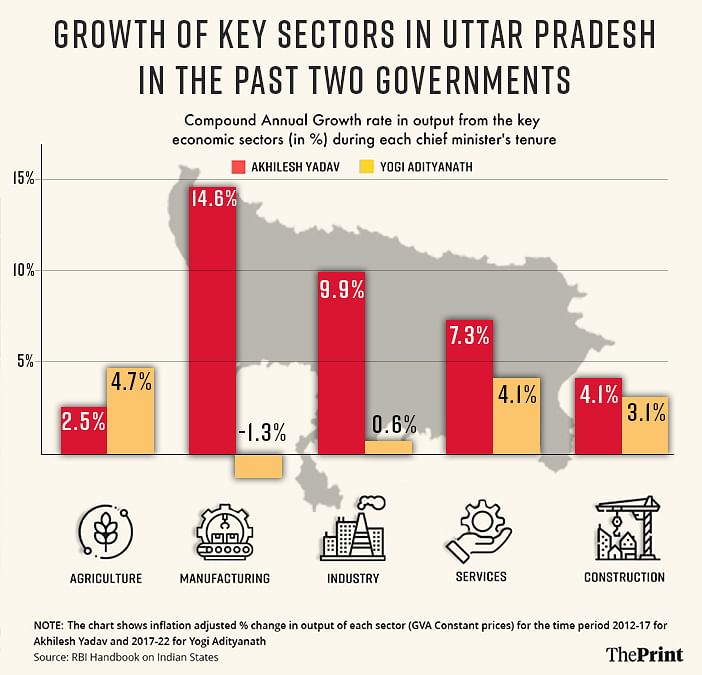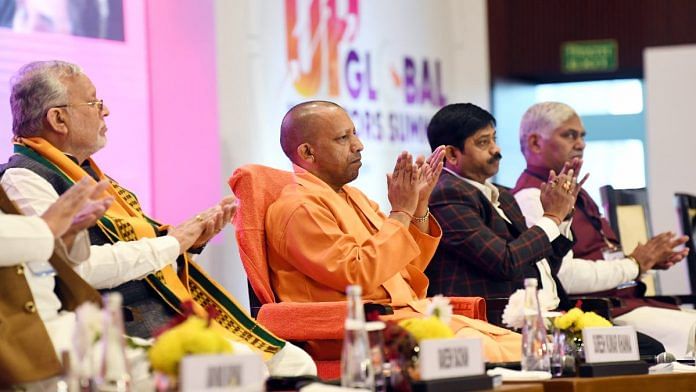New Delhi: India’s most populous state — Uttar Pradesh — has a dream, to become a trillion-dollar economy in the next five years. Since November, Chief Minister Yogi Adityanath has been saying that a blueprint is in the works to achieve this goal. The idea is to make UP, which contributes roughly 8 percent to India’s GDP, a key driver of PM Narendra Modi’s ambition to make the country a $5 trillion economy.
At current prices, Uttar Pradesh’s Gross State Domestic Product (GSDP) — the sum of the output from all sectors of the economy — stood at around $255 billion at the end of 2021-22, around a fourth of the target.
In real terms (at 2011-12 prices, a measure that accounts for inflation), it stood at Rs 11.8 trillion (approximately $155 billion) as of 31 March 2022, according to data from the Union Ministry of Statistics & Programme Implementation (MoSPI).
Speaking to ThePrint, experts said achieving the $1 trillion goal will require UP to grow at a minimum of 32 percent per annum — a rate they say the state has never even remotely seen.
Under Yogi Adityanath’s first term (2017 to 2022), UP’s GSDP growth rate averaged 3.2 percent annually — reaching Rs 11.8 trillion from Rs 10.12 trillion in 2016-17 (in real terms, 2011-12 prices).
In comparison, the GSDP growth rate was 6.9 percent per annum under Adityanath’s predecessor, Akhilesh Yadav (CM from 2012 to 2017) of the Samajwadi Party (SP).
When the latter came to office, UP’s GSDP stood at Rs 7.24 trillion.
Experts, however, point out that the figures need to be seen in context before a judgement is made on either’s administrative prowess. For one, they say, the country was still reeling under the impact of demonetisation when Adityanath took office. Secondly, they say, the figures for Akhilesh’s tenure may reflect the impact of a developmental spree he undertook after the jolt of the 2014 Lok Sabha polls.
Reached for comment, Alok Kumar, Principal Secretary to the government of UP (Planning & Programme Implementation) and nodal officer of the ‘One Trillion Dollar Economy’ project, made light of the numbers.
Kumar said they hoped to see the growth rate figure for 2021-22 and 2022-23 go up as the Government of India revised its figures following “adjustments”.
Also Read: Three reasons why Yogi Adityanath is sweating it out in UP urban local body polls
Growth trends
In the first three years of Yogi Adityanath’s tenure, the state’s GDP grew by 4 percent on average.
In 2016-17, Uttar Pradesh reported a GSDP growth rate of 11 percent in real terms, which fell to 4.4 percent by 2017-18. In 2018-19, its annual GSDP growth fell to 3.9 percent, and, in the last pre-pandemic year — 2019-20 — it was just over 3.9 percent, according to MoSPI data.
In 2020-21, when the effects of the Covid pandemic began to show, Uttar Pradesh’s GSDP shrank by 5.5 percent. India’s GDP shrank by 5.9 percent in the same period.

In 2021-22, Uttar Pradesh’s GSDP grew by 9 percent, which could be attributed to the low-base effect.
The slow growth in the state’s GSDP could at least partly be attributed to a decline in the state’s manufacturing sector, which formed 12.2 percent of the state’s GSDP in 2021-22, down from 15 percent in 2016-17.
Under the Akhilesh Yadav government (2012-2017), the industrial sector — of which manufacturing is a sub-sector — grew at about 10 percent each year (compounded annually).
In the first three years, the industrial sector grew by 2 percent on average each year. In 2015-16, the growth was 15 percent, and it was 28 percent in 2016-17.
The growth rate in the manufacturing sub-sector was 26 percent in 2015-16, and 47 percent in 2016-17, according to the data available at the UP Department of Economics and Statistics.
Meanwhile, the industrial sector (in real terms) shrank during Yogi Adityanath’s tenure.
In 2016-17, Uttar Pradesh’s industrial sector grew at 28 percent, but shrank by 4.7 percent in 2017-18. Despite a lowered base, the industrial sector growth stood at 1 percent in 2018-2019, and 3.5 percent in 2019-2020. During the pandemic, it shrank by 6.2 percent, and then grew by 10 percent in 2021-22.
Similar trends emerge in other sectors too. The average annual growth in agricultural output was 9.1 percent under Akhilesh Yadav and 8.6 percent during Yogi Adityanath’s first term.

Manufacturing grew by 14.6 percent under Akhilesh’s term and by 0.6 percent per annum on average under Yogi’s first. The service sector grew by 7.3 percent under Yadav and 4.1 percent under Adityanath. Construction grew by 4 percent under Akhilesh Yadav and 3.1 percent under Yogi.
Principal secretary Alok Kumar said one could not arrive at a trend from these numbers since the figures of increased growth in manufacturing in 2015-16 and 2016-17 were the “result of old adjustments” in data by the central government.
“The high increase of growth rate in the manufacturing sector does not pertain only to those years but is a result of adjustments of old calculations as well. One can understand that a growth rate of 47 percent in the manufacturing sector in a year is too good to be true and these figures cannot be seen as showing a trend,” he added.
The “adjustments” referred to by Kumar don’t find a mention in the data Uttar Pradesh government puts on its website.
When asked about the decrease in growth rate between 2017-18 and 2018-19, he said one couldn’t term it a dip. He said revisions by the central government in its figures following “more adjustments” could bring a spurt in the growth rate figure for 2021-22 and 2022-23 as well.
What explains UP’s growth path
Experts cite multiple reasons behind Uttar Pradesh’s growth trends.
First, they say, is the concentration of industrial activity in western parts of Uttar Pradesh. In a series on UP’s GSDP, published by ThePrint, it was found that, by 2020, about 68 percent of Uttar Pradesh’s manufacturing output came from just a few districts in its western parts, which are close to India’s capital Delhi.
“In my understanding, NOIDA has been the main mover of the state’s economy (contributing about 10 percent of this huge economy). If growth has slowed down, NOIDA (GB Nagar) should be looked into,” said Vikas Vaibhav, assistant professor of economics at the OP Jindal Global University in Sonepat.
“Even in NOIDA, the growth of the manufacturing sector, and real estate sector, needs to be looked into. I don’t think district domestic product data has been released after 2019-20 by UP-DES (Directorate of Economics and Statistics).”
Santosh Mehrotra, an economics professor at Jawaharlal Nehru University’s Centre for Informal Sector and Labour Studies, said there were certain political-economic factors at work behind UP’s GSDP numbers.
“When Akhilesh Yadav became the chief minister, it was often said in hearsay that the state had 4-5 CMs, one Akhilesh himself, his father and some of his chachas, who were conservative in their approach towards managing the state,” he added. “After losing in the 2014 Lok Sabha polls [SP won 5 seats], Akhilesh realised that in order to be re-elected as CM, he needed to take full control and overdid in terms of economic output to compensate for the loss he incurred in the first two-three years.”
“Being an engineer himself, and also an MBA, Yadav took business seriously, so a lot of highways, perhaps the Lucknow Metro, and other big developmental projects were completed in the last two years of his tenure, which may explain the spike in the GDP numbers during those years,” Mehrotra added.
The 2016 demonetisation might have also impacted Uttar Pradesh’s growth path, Mehrotra said.
“Uttar Pradesh is a labour-surplus state. During demonetisation, a lot of small and micro enterprises in the state were cash-strapped. These enterprises work on very small working capital, mostly cash, hence by the next financial year, their capacity to produce more was curtailed,” he added.
“Further, the state’s been more interested in inviting the big guns in its large investor summits. But they will only establish large-scale enterprises when it is safer to do so, the mafia that this government is fighting with seldom lets it happen.”
Talking about the state’s $1 trillion ambition, Mehrotra suggested it was a tall order.
“Forget quadrupling the size of the economy, even if it had to double its GDP size in this time, it will have to grow by more than 14 percent in real terms, a fate the state has never achieved.”
Vaibhav agreed that the goal was a bit too optimistic.
“My sense is that UP’s economy is not performing, despite the good intention of the government (and its officials). This is in line with the standard economic understanding that the government can only act as a facilitator/enabler, rather than being the prime mover in economic growth,” he said. “Only good intentions may not be enough.”
(Edited by Sunanda Ranjan)
Also Read: ‘Bhagirath-like effort needed’ as Yogi 2.0 revives trillion-dollar economy dream for UP



